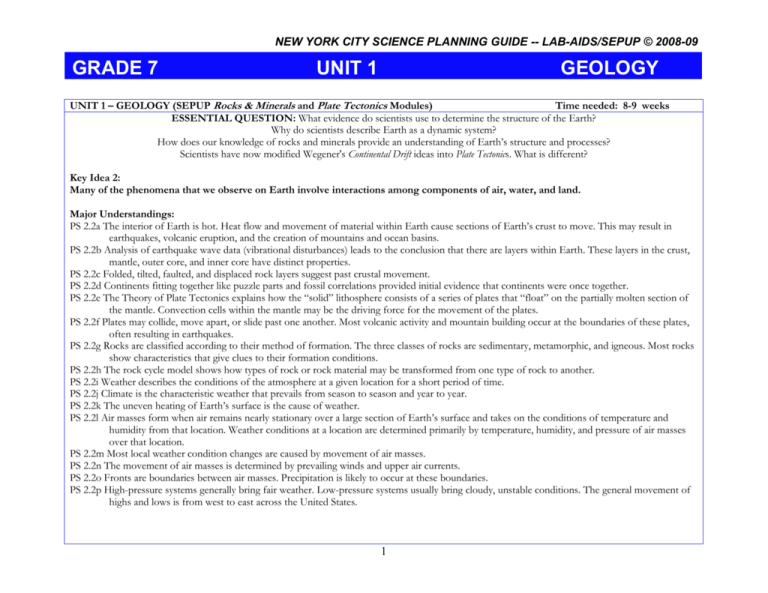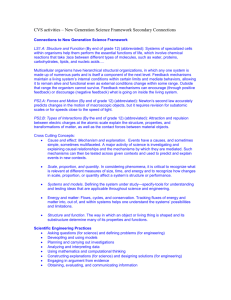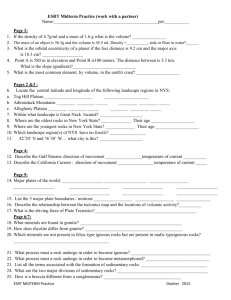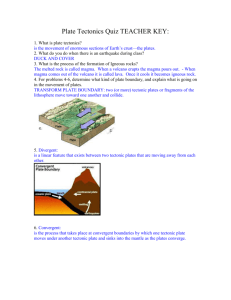NYC 7-1 GEOLOGY.v2.0
advertisement

NEW YORK CITY SCIENCE PLANNING GUIDE -- LAB-AIDS/SEPUP © 2008-09 GRADE 7 UNIT 1 GEOLOGY UNIT 1 – GEOLOGY (SEPUP Rocks & Minerals and Plate Tectonics Modules) Time needed: 8-9 weeks ESSENTIAL QUESTION: What evidence do scientists use to determine the structure of the Earth? Why do scientists describe Earth as a dynamic system? How does our knowledge of rocks and minerals provide an understanding of Earth’s structure and processes? Scientists have now modified Wegener's Continental Drift ideas into Plate Tectonics. What is different? Key Idea 2: Many of the phenomena that we observe on Earth involve interactions among components of air, water, and land. Major Understandings: PS 2.2a The interior of Earth is hot. Heat flow and movement of material within Earth cause sections of Earth’s crust to move. This may result in earthquakes, volcanic eruption, and the creation of mountains and ocean basins. PS 2.2b Analysis of earthquake wave data (vibrational disturbances) leads to the conclusion that there are layers within Earth. These layers in the crust, mantle, outer core, and inner core have distinct properties. PS 2.2c Folded, tilted, faulted, and displaced rock layers suggest past crustal movement. PS 2.2d Continents fitting together like puzzle parts and fossil correlations provided initial evidence that continents were once together. PS 2.2e The Theory of Plate Tectonics explains how the “solid” lithosphere consists of a series of plates that “float” on the partially molten section of the mantle. Convection cells within the mantle may be the driving force for the movement of the plates. PS 2.2f Plates may collide, move apart, or slide past one another. Most volcanic activity and mountain building occur at the boundaries of these plates, often resulting in earthquakes. PS 2.2g Rocks are classified according to their method of formation. The three classes of rocks are sedimentary, metamorphic, and igneous. Most rocks show characteristics that give clues to their formation conditions. PS 2.2h The rock cycle model shows how types of rock or rock material may be transformed from one type of rock to another. PS 2.2i Weather describes the conditions of the atmosphere at a given location for a short period of time. PS 2.2j Climate is the characteristic weather that prevails from season to season and year to year. PS 2.2k The uneven heating of Earth’s surface is the cause of weather. PS 2.2l Air masses form when air remains nearly stationary over a large section of Earth’s surface and takes on the conditions of temperature and humidity from that location. Weather conditions at a location are determined primarily by temperature, humidity, and pressure of air masses over that location. PS 2.2m Most local weather condition changes are caused by movement of air masses. PS 2.2n The movement of air masses is determined by prevailing winds and upper air currents. PS 2.2o Fronts are boundaries between air masses. Precipitation is likely to occur at these boundaries. PS 2.2p High-pressure systems generally bring fair weather. Low-pressure systems usually bring cloudy, unstable conditions. The general movement of highs and lows is from west to east across the United States. 1 NEW YORK CITY SCIENCE PLANNING GUIDE -- LAB-AIDS/SEPUP © 2008-09 GRADE 7 UNIT 1 GEOLOGY General Skills (from NYS Core Curriculum) GS 1. follow safety procedures in the classroom and laboratory GS 2. safely and accurately use the following measurement tools: metric ruler, balance, stopwatch, graduated cylinder, thermometers, spring scale, voltmeter GS 3. use appropriate units for measured or calculated values GS 4. recognize and analyze patterns and trends GS 5. classify objects according to an established scheme and a student-generated scheme GS 6. develop and use a dichotomous key GS 7. sequence events GS 8. identify cause-and-effect relationships GS 9. use indicators and interpret results Physical Setting Skills (from NYS Core Curriculum) PSS1. given the latitude and longitude of a location, indicate its position on a map and determine the latitude and longitude of a given location on a map PSS 2. using identification tests and a flow chart, identify mineral samples PSS 3. use a diagram of the rock cycle to determine geological processes that led to the formation of a specific rock type PSS 4. plot the location of recent earthquake and volcanic activity on a map and identify patterns of distribution PSS 5. use a magnetic compass to find cardinal directions PSS 6. measure the angular elevation of an object, using appropriate instruments PSS 7. generate and interpret field maps including topographic and weather maps PSS 8. predict the characteristics of an air mass based on the origin of the air mass PSS 9. measure weather variables such as wind speed and direction, relative humidity, barometric pressure, etc. PSS 10. determine the density of liquids, and regular- and irregular-shaped solids PSS 11. determine the volume of a regular- and an irregular-shaped solid, using water displacement PSS 12. using the periodic table, identify an element as a metal, nonmetal, or noble gas PSS 13. determine the identity of an unknown element, using physical and chemical properties PSS 14. using appropriate resources, separate the parts of a mixture PSS 15. determine the electrical conductivity of a material, using a simple circuit PSS 16. determine the speed and acceleration of a moving object This information is provided to help you in your unit planning. The time needed is an average, based on 45-50 minute class periods. Those activities that can be skipped without undue impact on the conceptual flow or skills foundation are marked with an asterisk (*) and were not included in the weekly time blocks. 2 NEW YORK CITY SCIENCE PLANNING GUIDE -- LAB-AIDS/SEPUP © 2008-09 GRADE 7 12* 13 WEEK 1 14 15 WEEK 2 16 17* UNIT 1 Title/Description Key Concepts & Processes Observing Natural Resources Students examine and rank four natural resources from most to least valuable. Diamond Dilemma Students gather data on an unidentified mineral that appears to be a diamond. Observational skills, natural resources, renewable and nonrenewable resources, using literacy Scientific inquiry, data collection, physical properties, using mathematics Analyzing Diamond Data Students compare data on the unidentified mineral to that of four known materials and then identify the sample as fluorite. Mineral Properties A reading on minerals and their properties introduces the idea that rocks are made of minerals. Mineral Identification Students design an investigation to identify an unknown mineral. The Minerals in Rocks Students select and test a single property to determine whether the mineral found in two different rock samples is calcite or quartz. GEOLOGY Advance Prep Teaching Notes to teachers periods SEPUP ROCKS AND MINERALS MODULE Assessment 1-2 Alignment to NYS Core Curriculum GS 4, GS 5 Homework: Research important natural resources in New York state. GS 1, GS 4, PSS 2 Copy student sheets 1-2 Scientific inquiry, physical properties, data analysis Copy student sheets 1 AQ 5: RE (p. TR-166) GS 4, PSS 2 Natural resources, minerals, rocks, properties Using literacy Get index cards, overhead projector; copy student sheets 1-2 Quick Check Scientific inquiry, minerals, properties, data analysis Need safety goggles, paper towels, water, overhead projector 2-3 Quick Check Proc: DI (p. TR-162) AQ 3: RE (p. TR-166) PSS 2, GS 4 Homework: What important minerals are found in New York State? GS1, GS 3, PSS 2 Need safety goggles, paper towels, water; copy student sheets 1-3 Extension: Web site, additional mineral tests Scientific inquiry, minerals, rocks, properties, data analysis, use literacy skills 3 GS1, GS 4, PSS 2 NEW YORK CITY SCIENCE PLANNING GUIDE -- LAB-AIDS/SEPUP © 2008-09 GRADE 7 18* 19 WEEK 3 20 21* 22 23* UNIT 1 GEOLOGY Title/Description Key Concepts & Processes Advance Prep Notes to teachers Teaching periods Assessment Alignment to NYS Core Curriculum Every Rock Tells a Story Students analyze the content of a fictional newspaper story that describes the alleged discovery of diamonds in a national forest. Rock Formation The formation of sedimentary, igneous, and metamorphic rocks is explained in the context of coal, kimberlite, and marble formation. Minerals, rocks, relationship between them, use literacy skills Copy student sheets 1-2 Quick Check GS 4, PSS 2 Copy student sheets 1-2 Quick Check PS2.2g Identifying Rock Types Students observe and identify rocks as either igneous, sedimentary, or metamorphic. Modeling Rock Layers Students model the formation of sedimentary rock layers. The Rock Cycle Game Students play a game that models the rock cycle. Igneous rock, sedimentary rock, metamorphic rock, Copy student sheets 2-3 Procedure: GI (p. TR-170) PS2.2g Sedimentary rocks, modeling, variable, range, using mathematics Get watches or clocks, overhead projector 1-2 Rock cycle, igneous rock, Get overhead sedimentary rock, projector; copy metamorphic rock, magma student sheets 1-2 Making Minerals Students evaluate data on mined vs. manufactured diamonds and discuss their relative value. Natural resources, minerals, properties, using literacy skills 1-2 Homework: *Can assign for homework if desired. Igneous rock, sedimentary rock, metamorphic rock, magma, use literacy skills Homework: Prepare for the lab in activity 20 Get overhead projector; copy student sheets 4 PS2.2g AQ 7: UC (p. TR-165) AQ 3: ET (p. TR-167) PS2.2g, PS2.2h Homework: Make up 3 new “earth event” cards for the Rock Cycle Game PSS 2 NEW YORK CITY SCIENCE PLANNING GUIDE -- LAB-AIDS/SEPUP © 2008-09 Title 36 Volcanic Landforms Students consider the constructive nature of volcanoes as they model the effects of two different kinds of volcanic eruptions. 38 Beneath the Earth’s Surface Students construct diagrams describing earth’s interior before and after they read about volcanoes and earth layers Earth Time Students are introduced to the age of the earth as they place important events in earth’s history into one of four time periods. WEEK 4 37 39 WEEK 5 Storing Waste Earthquakes and volcanoes are introduced as students analyze evidence related to the storing of nuclear waste at Yucca Mountain, Nevada. Key Concepts & Processes Advance Prep Notes to teachers Teaching periods SEPUP PLATE TECTONICS MODULE Observational skills, natural Copy student 2 resources, sheets renewable/nonrenewable, Using literacy skills Homework: Do other countries depend on nuclear power? Research this question. Scientific inquiry, data collection, physical properties, using literacy skills Volcano, magma, landform, model, using literacy and mathematics Geological time, paleontologist Extension: Visit the American Museum of Natural History web site (www.amnh.org) to learn more about earth’s past. Need class set of paper towels, safety goggles, meter sticks (optional); prep the vinegar/baking soda mixtures, and volcano molds Copy student sheets; need overhead projector, calculators,apple, knife, compasses (optional) Copy student sheets; need overhead projector, get self-stick notes (optional) 5 Assessment AQ 2 ET (p. TR-167) 1 1-2 1-2 Alignment to NYS Core Curriculum GS 7, GS 8 PS2.2a, PS2.2g, GS 1, GS 2 Quick Check AQ 5 UC (p. TR-165) PS2.2a, PS2.2b, GS 7 NEW YORK CITY SCIENCE PLANNING GUIDE -- LAB-AIDS/SEPUP © 2008-09 40* 41 WEEK 6 42 43* Title Key Concepts & Processes Advance Prep Notes to teachers Teaching periods The Continent Puzzle Students use puzzle pieces representing the earth’s continents to begin to investigate continental drift. Continental Drift Students consider the historical development of the idea of continental drift as they evaluate related evidence. The Theory of Plate Tectonics Students watch a short video on the history of the theory of plate tectonics, beginning with Wegener’s theory of continental drift. Measuring Earthqakes Students model how a seismograph records earthquakes as they explore the relationship between earthquakes and plate boundaries. Introduction to continental drift, fossil evidence, geological time, Pangea Copy student sheet; need overhead projector 1 Continental drift, evidence Using literacy. Copy student sheet; need overhead projector 1 Continental drift, plate tectonics and its relationship to earthquakes, volcanoes, mountains, Using literacy. Need VCR and TV monitor; copy student sheets 1-2 Earthquakes, plates, seismogram, seismograph, fault (optional) Need plain white paper, overhead projector 2-3 Homework: Can be assigned as homework. 6 Assessment Alignment to NYS Core Curriculum PS2.2d,GS 4 Quick Check AQ 3: UC (p. TR-165) AQ 3: SI (p. TR-169) PS2.2c, PS2.2d, PS2.2c, PS2.2d, PS2.2e, PS2.2f Procedure: GI (p. TR-170) PS2.2a, PS2.2f NEW YORK CITY SCIENCE PLANNING GUIDE -- LAB-AIDS/SEPUP © 2008-09 WEEK 7 44 45 46* WEEK 8 47 48 Title Key Concepts & Processes Advance Prep Notes to teachers Teaching periods Mapping Plates Students compare the nature and shape of continents vs. plates as they label major plates and use earthquake and volcano data to plot and draw missing plate boundaries. Understanding Plate Boundaries Students read about how plate tectonics helps explain earthquakes, volcanoes, and mountain ranges. Convection Currents Students explore the mechanism behind plate motion in convection currents. Spreading Plates Students use a computer simulation to investigate what happens when earth’s plates move apart. Other Types of Plate Motion Students use a computer simulation to investigate what happens when earth’s plates collide as well as slide past each other. Continents, plates, lithosphere, risk Using literacy Need dark-colored markers and lightcolored pencils, overhead projector; copy student sheets 1 Copy student sheet 1-2 Need warm and cold water, paper towels/sponge, overhead projector 1-2 Extension: Visit the SEPUP website (www.sepupplhs.org) to find out more about plate movement. Convergent, divergent, transform, subduction, hot spot (optional) Using literacy Homework: Research mountain ranges in New York state. Convection current, magma, mantle Assessment Alignment to NYS Core Curriculum PS2.2f, PSS 4 Quick Check PS2.2e, PS2.2f PS2.2b, PS2.2e Divergent boundary, plates, lithosphere, mantle, geologic time Need computers with Internet access, overhead projector; copy student sheet 1 Quick Check PS2.2a, PS2.2f, GS 8 Convergent, transform, subduction, lithosphere, mantle, geological time Need computers with Internet access; copy student sheet 1-2 AQ 4: UC (p. TR-165) PS2.2a, PS2.2f, GS 8 7 NEW YORK CITY SCIENCE PLANNING GUIDE -- LAB-AIDS/SEPUP © 2008-09 Title 49 29* 58* 60* Key Concepts & Processes Advance Prep Notes to teachers Teaching periods Assessment Alignment to NYS Core Curriculum Comparing Site Risk Nuclear waste, earthquakes, Copy student 1-2 AQ 2: ET PS2.2a, PS2.2f Students draw on their volcanoes, risk, evidence, sheets (p. TR-167) knowledge of the risk trade-offs of earthquakes and Using literacy volcanoes to compare storing nuclear waste at three different sites, including Yucca Mountain. THE FOLLOWING ACTIVITIES ARE OPTIONAL AND INCLUDED IN THE TEACHER’S GUIDE ONLY Weathering, erosion Constructive and destructive Copy student 1-2 AQ2: UC and deposition processes, weathering, sheets Students read about erosion, deposition, human weathering, erosion and activity and earth processes deposition and about the impact of human activity on these processes. The Causes of Climate, sun’s energy, Get heat lamp 1 PS 2.2j Climate oceans, landforms (ptional) Students read about more factors affective climate, including the sun’s energy. The Changing States States of water (solid, liquid, Safety goggles, hot 1-2 PS 2.2o of Water gas), water vapor, clouds, plate, plastic Students are introduced condensation, evaporation, bootle, glass to the different forms water cycle beaker, matches, of water and how they incense, tongs, ice, change from one to access to freezer, another. sheet of black paper; copy student sheets 8 NEW YORK CITY SCIENCE PLANNING GUIDE -- LAB-AIDS/SEPUP © 2008-09 62* 64* 66* 8* Title Key Concepts & Processes Advance Prep Notes to teachers Teaching periods Traveling on the Water Cycle Students simulate traveling with water molecules through the water cycle. After completing the simulation, students write a story that describes traveling with their water. Earth’s Atmosphere Students use a computer simulation to sample air composition, temperature, and pressure at different altitudes above earth’s surface. Atmosphere and Climate A reading about the relationship between atmosphere and climate. Measuring Volume Students use two methods – measurement and calculation and water displacement – to determine volume. Models, states of water, water vapor, clouds, condensation, evaporation, water cycle, literacy Get picture of water cycle, one liter container, m9 mL graduated tube: copy student sheets 1-2 Layers of atmosphere, atmospheric composition, air pressure, water vapor Internet access needed, gather calculators, prepare student sheets 1-2 Atmosphere, wind, atmospheric layers and composition Linear measurement, volume, measurement, calculation of volume 1 Assessment AQ 4: SI Alignment to NYS Core Curriculum PS 2.2o PS 2.2j, 2.2m, 2.2n AQ2: UC PS 2.2j, 2.2m, 2.2n, 2.2o, 2.2p, PSS 8, 9 Copy student shets, collect calculators, tape markers, various objects to determine volume 9 1-2 AQ6: UC PSS 10, 11 NEW YORK CITY SCIENCE PLANNING GUIDE -- LAB-AIDS/SEPUP © 2008-09 9* 10* Title Key Concepts & Processes Advance Prep Notes to teachers Measuring Mass, Calculating Density Students measure mass and calculate density in order to identify six metal objects. Density of Unknown Solids Students calculate density in order to identify unknown solids Density, mass measurement, use of equations Copy student sheets, collect balances calculators, Writing procedures, determining density, identifying unknowns, using mathematics Collect at least 16 product labels, calculators, index cards, balances; cop student sheets 10 Teaching periods Assessment Alignment to NYS Core Curriculum 1-2 AQ 3e: UC PSS 10, 11 2 AQ 1: AD Proc: DI PSS 10, 11






